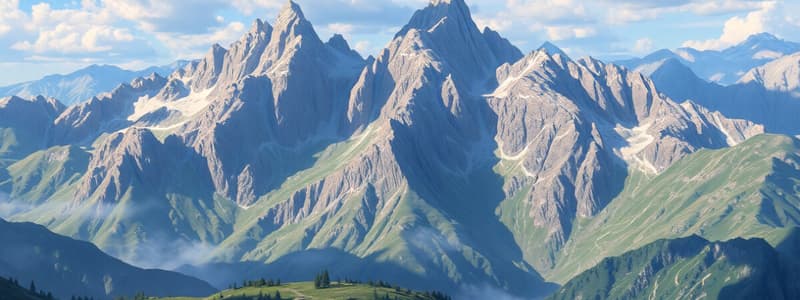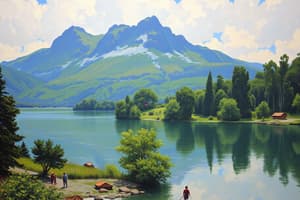Podcast
Questions and Answers
Gjeologjia e Greqisë përfshin formacione vullkanike më të reja në territorin e saj.
Gjeologjia e Greqisë përfshin formacione vullkanike më të reja në territorin e saj.
True (A)
Serbia ka një gamë të larmishme vegetacioni që përfshin vetëm stepat.
Serbia ka një gamë të larmishme vegetacioni që përfshin vetëm stepat.
False (B)
Maqedonia është kryesisht e përbërë nga shkëmbinj metamorfik dhe gëlqerorët.
Maqedonia është kryesisht e përbërë nga shkëmbinj metamorfik dhe gëlqerorët.
True (A)
Greqia ka rezerva të rëndësishme drushtore në pyjet e saj bregdetare dhe të brendshme.
Greqia ka rezerva të rëndësishme drushtore në pyjet e saj bregdetare dhe të brendshme.
Maqedonia ka probleme në menaxhimin e burimeve të saj minerale dhe drushtit.
Maqedonia ka probleme në menaxhimin e burimeve të saj minerale dhe drushtit.
Terreni i Serbisë përfshin Alpet Dinarike në jug.
Terreni i Serbisë përfshin Alpet Dinarike në jug.
Maqedonia ka një klimë më të ftohtë në dimër dhe më të nxehtë në verë.
Maqedonia ka një klimë më të ftohtë në dimër dhe më të nxehtë në verë.
Greqia është një vend kryesisht i sheshtë me pak malësi.
Greqia është një vend kryesisht i sheshtë me pak malësi.
Rrethi i Vardarit është një nga lumenjtë kryesorë të Maqedonisë.
Rrethi i Vardarit është një nga lumenjtë kryesorë të Maqedonisë.
Pana është një nga lumenjtë më të rëndësishëm që rrjedh në Serbi.
Pana është një nga lumenjtë më të rëndësishëm që rrjedh në Serbi.
Klimi në Greqi është kryesisht mesdhetar, me dimra të lagësht dhe verëra të thata.
Klimi në Greqi është kryesisht mesdhetar, me dimra të lagësht dhe verëra të thata.
Malet e Ballkanit ndodhen në veri të Maqedonisë.
Malet e Ballkanit ndodhen në veri të Maqedonisë.
Sistemi hidrologjik i Greqisë përfshin lumi si Vardari dhe Aksios.
Sistemi hidrologjik i Greqisë përfshin lumi si Vardari dhe Aksios.
Flashcards
Gjeologjia e Maqedonisë
Gjeologjia e Maqedonisë
Maqedonia kryesisht përbëhet nga shkëmbinj gëlqerorë dhe metamorfikë, karakteristikë e Maleve Ballkanike.
Burime natyrore të Serbisë
Burime natyrore të Serbisë
Serbia posedon burime natyrore si depozita minerale, kryesisht bakër dhe plumbi, si dhe dru nga pyjet e saj.
Bimësia e Greqisë
Bimësia e Greqisë
Bimësia e Greqisë ndryshon konsiderueshëm nga zonat malore me pyje bredhi deri te bimësia mesdhetare e përbërë nga pemë ulliri, vreshta dhe specie të ngjashme përgjatë brigjeve. Tokat e kultivuar janë të dukshme në nivelet më të ulëta.
Pyjet e Maqedonisë
Pyjet e Maqedonisë
Signup and view all the flashcards
Burimet e Greqisë
Burimet e Greqisë
Signup and view all the flashcards
Lëndësia e Serbisë
Lëndësia e Serbisë
Signup and view all the flashcards
Lëndësia e Maqedonisë
Lëndësia e Maqedonisë
Signup and view all the flashcards
Lëndësia e Greqisë
Lëndësia e Greqisë
Signup and view all the flashcards
Klima e Serbisë
Klima e Serbisë
Signup and view all the flashcards
Klima e Maqedonisë
Klima e Maqedonisë
Signup and view all the flashcards
Klima e Greqisë
Klima e Greqisë
Signup and view all the flashcards
Lumi i Danubit
Lumi i Danubit
Signup and view all the flashcards
Lumi Vardari
Lumi Vardari
Signup and view all the flashcards
Study Notes
Physical Geography of Serbia, Macedonia, and Greece
-
Serbia: Situated in Southeastern Europe, Serbia's terrain is diverse, encompassing the Pannonian Plain in the north, the Dinaric Alps in the west, and the Balkan Mountains in the south. It features various river systems, notably the Danube. Significant elevations exist.
-
Macedonia: Located in the Balkans, Macedonia exhibits a mountainous landscape, primarily a part of the Balkan Range. The Šar Planina, Bistra, and Jakupica Mountains are prominent geographical features. Rivers like the Vardar and Struma are important for drainage.
-
Greece: A predominantly mountainous country, Greece comprises various ranges in the mainland and islands. The Pindus Mountains are a major chain in the mainland forming a key divide. The Aegean Sea and Ionian Sea surround the nation, impacting its climate and coastlines. Extensive coastal plains are found in some regions.
Climate
-
Serbia: Serbia's climate varies with altitude, ranging from humid continental in the north to a Mediterranean climate in the southern regions.
-
Macedonia: A more continental climate characterizes Macedonia, with cold winters and hot summers. Precipitation patterns vary, with higher values in the mountainous areas.
-
Greece: The climate in Greece is primarily Mediterranean, characterized by mild, wet winters and warm, dry summers. Variations exist based on elevation and proximity to the sea.
Hydrology
-
Serbia: The Danube River is a major river running through Serbia, along with tributaries like the Sava River. Multiple smaller rivers also flow through the country's diverse landscapes impacting its hydrology.
-
Macedonia: The Vardar River is crucial for Macedonia's hydrology, carrying significant water flow across the landscape. The Struma River, another important water source, also contributes significantly to the water resources in the region.
-
Greece: Rainfall patterns are diverse in Greece, but the major rivers, like the Vardar and the Axios, flow across the mainland impacting its hydrological systems. Rainfall is crucial, particularly to the lower elevations. The Aegean Sea and Ionian Sea are vital factors in Greece's hydrology. The many islands also have diverse water resources.
Geology
-
Serbia: Serbia's geological composition includes elements of the Pannonian Basin and the Dinaric Alps, which contribute to its diverse geomorphology as well as its mineral resources.
-
Macedonia: Macedonia is primarily composed of limestone and metamorphic rocks characteristic of the Balkan Mountains. This affects the terrain and the potential for resources.
-
Greece: Greece's geology varies depending on region and island. The mainland consists of ancient metamorphic rocks as well as more recent volcanic formations. The islands also vary in geological origin reflecting their formation. Fault lines and volcanic activity are possible in some areas.
Vegetation
-
Serbia: The Serbian vegetation range from forests covering the mountainous areas to grasslands and steppes in the plains depending on precipitation and altitude affecting Serbia's vegetation.
-
Macedonia: Forests cover significant parts of the mountainous terrain, mixed with areas of grassland and shrubland. Agricultural practices have modified the landscape.
-
Greece: Greece's vegetation varies considerably from the mountainous areas with coniferous forests to Mediterranean vegetation encompassing olive trees, vineyards, and other similar species along the coastlines. Cultivated lands are prominent in lower elevations.
Natural Resources
-
Serbia: Serbia possesses resources such as mineral deposits, notably copper and lead, as well as timber from its forests.
-
Macedonia: Potential mineral resources along with timber from its forested regions, which need careful management.
-
Greece: Greece has deposits of various minerals. Coastal and inland forests present significant timber reserves. Tourism is also an important aspect to consider amongst these resources.
Studying That Suits You
Use AI to generate personalized quizzes and flashcards to suit your learning preferences.




